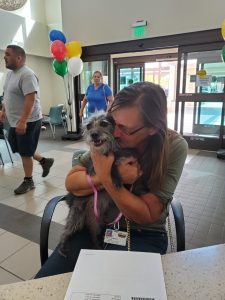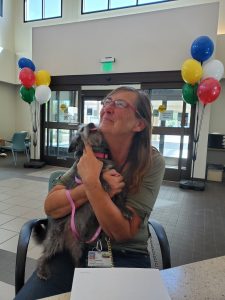
On September 23, 2019, a black and silver terrier named “Mia” was brought into the County of Los Angeles Palmdale Animal Care Center (ACC) as a stray by a Good Samaritan. Staff at the Palmdale ACC were able to quickly identify Mia’s owner because Mia had been microchipped and the chip was registered. Calls were placed to Mia’s owner to let her know we had her pet. The owner noticed several missed calls from an unknown number, but returned the call the next day. She discovered the reason for the calls and was very perplexed. She told Sgt. Chris Valles that she hasn’t had a dog in years and was sure this wasn’t her dog. Sgt. Valles reviewed DACC’s database and advised the caller that our records reflected she was the owner of a terrier named Mia.
The owner exclaimed over the phone, “Yes, MIA!” She was crying tears of joy and shared that Mia was playing in her fenced yard but was stolen seven years ago. She had searched for Mia for more than a year with no luck. She thought she would never find her. Sgt. Valles was happy to share with Mia’s mom that Mia was healthy, safe, and ready to come back home.
Studies show one in three pets will become lost at some point during their lifetime. This is why veterinarians strongly encourage microchipping. Microchipping increases the likelihood of a pet returning home by offering secure, reliable, unique, and permanent identification.
 Hundreds of thousands of lost pets have been reunited with their distraught families because the pets were microchipped. While tags can become lost or damaged and tattoos can fade or be altered, microchips provide permanent identification that cannot be changed. Due to the presence of a microchip, DACC has reunited owners with pets that had been missing for many years
Hundreds of thousands of lost pets have been reunited with their distraught families because the pets were microchipped. While tags can become lost or damaged and tattoos can fade or be altered, microchips provide permanent identification that cannot be changed. Due to the presence of a microchip, DACC has reunited owners with pets that had been missing for many years
Mia’s mom left work immediately and arrived at the Palmdale animal care center overwhelmed with so much emotion. Upon seeing Mia, Mia’s mom began crying tears of joy and thanked us repeatedly. Mia remembered her mom, her tail starting wagging and soon her entire body was wiggling attempting to jump out of our animal care attendant’s arms. We are so happy to see the two reunited and Mia was very happy to go back home.
What is a Microchip?
Microchipping is a simple, non-surgical procedure. Microchipping of animals is a customary practice – millions of dogs and cats, horses, livestock, birds, wildlife, and endangered species are chipped. It is an identification that cannot be lost, falsified, or altered, and is essential to reuniting lost pets with their families. The microchip is approximately the size of a grain of rice and is injected beneath the skin with a needle, similar to a vaccination. There is no anesthesia required and even the smallest animals such as fish, puppies, and kittens can be safely micro-chipped
Each microchip has a unique code number. When a special, hand-held scanner is passed over the area where the microchip has been implanted, the scanner “reads” the microchip and displays its code number. Code numbers are stored in a national database where the owner’s contact information is maintained. An animal care agency can then retrieve the owner information from the database and contact the owner so they can promptly recover their pet.
Additional Details to Note
Microchipping a pet is a simple process that takes minutes. If your pet is not micro-chipped, please visit our website https://animalcare.lacounty.gov/microchips/ for more details about DACC’s low-cost vaccine/microchip clinics for dog and cats. Microchips are $7.50 which does not include registration. Also, you can reach out to your local veterinarian for micro-chipping.
For more details about the registration process, visit www.akcreunite.org
